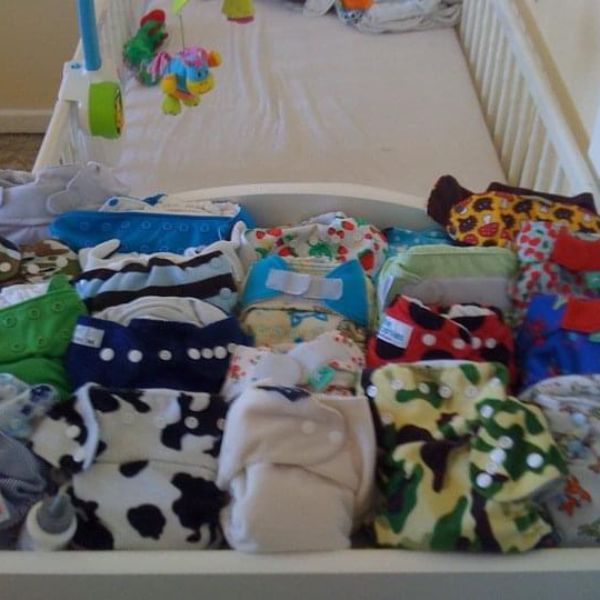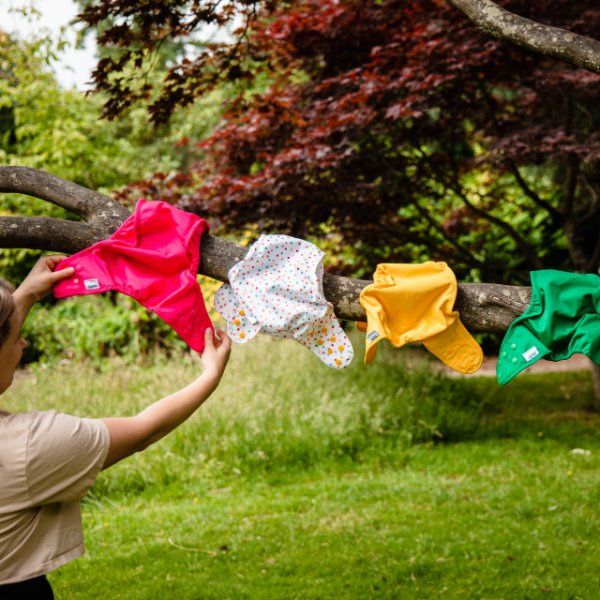Second-Hand Reusable Nappies: Everything You Need to Know18 September 2024 Buying second hand nappies was one of my favourite parts of using cloth nappies. I can't remember the brand but there was a glow in the dark nappy wrap that I loved, it was limited edition, super expensive and not available from any UK retailers but I nabbed one preloved and my son LOVED it. 
Most of these were bought second hand and all were sold on when my son potty trained. Whether you’re just starting out with cloth nappies or looking to save money while making an environmentally friendly choice, second-hand nappies could be the way to go. In this blog, we’ll cover everything from the benefits to the important things to check before buying. What Are Second-Hand Nappies?Second hand nappies are washable nappies that have been used by someone elses baby that are being handed on. They are often called preloved nappies. Pre-loved cloth nappies that have been used by other families and are being resold or donated. Cloth nappies are made from durable materials like cotton, bamboo, hemp or microfiber, they are designed to last through multiple uses and can be just as effective as new nappies when properly cared for. By sourcing second-hand, parents can save money while also reducing waste and lessen their impact on the environment. Benefits of Second-Hand NappiesThe benefits of buying second-hand nappies is similar to buying anything else used - - Second-hand reusable nappies are cheaper than new
- Second-hand washable nappies reduce waste and are kinder to the planet, extending the life of the materials used
- Second-hand cloth nappies are more comfortable than disposables with less chemicals and better for sensitive skin
- Second-hand modern cloth nappies allow you to try a type or brand without committing too much expense
- Second-hand reusable baby nappies can bulk up your stash for a low cost allowing you to save money
- Second-hand washable diapers will be more absorbent than new ones as the fibres have been primed to absorb
- Second-hand cloth diapers allow you to source out of stock or limited edition prints
- Second-hand modern cloth diapers can also be sold on by you when baby potty trains, often getting your full spend back!
- Second-hand nappies promote a circular economy of reusing, reducing manufacturing demand and conserving resources.
Are Second-Hand Reusable Nappies Safe?Yes, second-hand reusable nappies are safe, but you should have a checklist of questions for the seller before purchasing them to assess their condition - and then a thorough strip wash routine to make sure they are clean and hygienic ready for your baby to use. This will give you peace of mind that they are sanitary and safe. Before buying- Check there have been no product recalls
- Ask about the wash routine used
- What detergent has been used
- How old are the nappies
- Has baby been unwell in the nappies
- Has baby had any rashes
- Are the leg elastics still tight
- Are the poppers all functioning
- Is the velcro dirt and fluff free
- Are the boosters or inserts included
- How many children have used them
- Is there any wear and tear
- Question whether they will honour returns if there are any issues
- Ask about stains
After buying- Thoroughly check the leg elastic - they should be stretchy with no brittle areas
- Check the velcro and poppers
- Check for stains
- Sniff test for ammonia (gross but useful)
- Do an extended rinse in the machine without any other items
- Strip wash using your normal detergent, laundry sanitiser, or oxi action laundry bleaches (avoid any other bleaches)
- Finish with a long rinse again
- Hang to dry in the sun or a sunny window
.jpg) Material & ConditionReusable nappy inserts and boosters become more absorbent over use so second hand diapers can be super absorbent and bomb proof. However, nappy wraps and pockets with waterproofing can breakdown over time. SanitisationIt is very important that you make sure second-hand nappies are clean and free from bacteria and contamination before you use them on your baby. Sometimes smells and stains might not show up until you have washed them. Strip washing is a deep clean that will remove any detergent build up or ammonia that can lead to rashes. Pre-wash with your normal detergent then rinse. Wash to the maximum heat the nappies allow - 60 degrees for anything without PUL and bio powder as the enzymes can breakdown bacteria more effectively than non-bio. Vinegar can be added to your fabric softener drawer as an extra cleanser during the main long wash. Then rinse, rinse, and rinse again! You want to see no suds through the washing machine door. 
Air dry nappies in the suns UV rays - natures sanitiser. Product RecallsCheck for product recalls on the ACCC (Australian Competition & Consumer Commission) and Product Safety Australia websites, in case the second-hand nappy is impacted. Age of NappiesAsk how long the nappies have been used, PUL and other waterproof layers can degrade over time and if nappies have been in storage. Tips for Buying Second-Hand Reusable NappiesUse this checklist of tips for buying second hand reusable nappies: Buy from Reputable SourceThe cloth bum worlds is really open and inclusive and most selling pages on social media are public and any over priced or dodgy listings should be flagged by admins or other mums Ask About the Nappy’s Historyask how big their stash is (to determine how heavy the usage was), how many children have used them, and whether they have been in storage. Be cautious of sellers that aren't open to questions InspectIf buying online study any photos and ask questions about the general condition including signs of wear and tear, such as thinning or balding fabric, holes, or damaged elastics. If buying in person stretch the elastics, test the velcro is still sticky and give a sniff test! Ask for extra photosDon't feel shy to ask for further photos and close ups if you have any queries Price checkMake sure you are getting a fair deal. Run a search on the selling page you are using, or vinted / ebay / gumtree to see how much the nappy you are after sells for. Remember prices vary depending on age, condition, demand and rarity Look for bundlesIf you want to save money on your workhorse nappies so you can splurge on the odd new wrap with beautiful prints, look for bundles of inserts, boosters or fitted nappies that are going to be hidden anyway under wraps BarterBe ready to negotiate, sellers want to be rid of old nappies and recoup some of their original spend especially if the listing has been up for a while. If sellers have multiple nappies you want, ask for a reduction for buying more than one Choosing reusable nappies—especially second-hand—helps reduce the amount of waste going to landfills. Disposable nappies take hundreds of years to decompose, so reusing nappies is a fantastic way to lessen your environmental footprint. If this article was useful for you, you might want to read - Sanitising Cloth Nappies Beginners guide to reusable nappies Are reusable nappies hygienic? If you need any more guidance, drop the team a line or come and find me on the online chat UK time 10am-2pm. We use the products everyday and LOVE to chat nappies, poo and wee, all day long, nothing is TMI and we all love to overshare based on our own experiences... About the Author: Kirstin is part of the Customer Experience team at Cheeky Wipes, which since 2008 has been selling the original reusable wipes kit. She is mum to three kids and loves the forest, the sea and the hills! Along with the rest of our crack team, she spends most days talking about poo, pee and periods and loves a chance to overshare. Cheeky wipes were recognised with a Queens Award for Enterprise in Sustainable Development in 2021, celebrating their hard work over the last 13 years. |